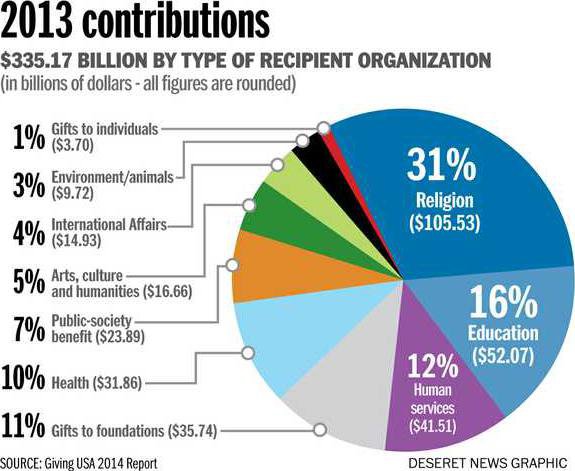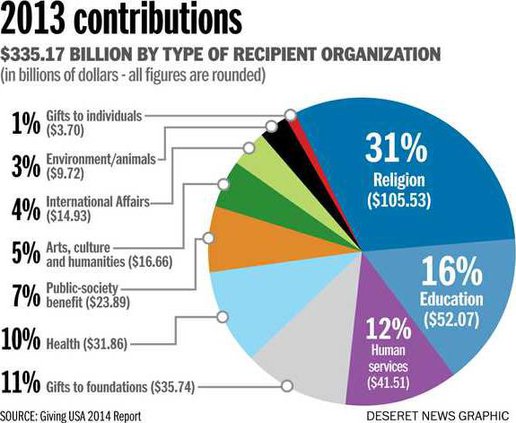The Philippines super typhoon Haiyan displaced more than 6 million people on Nov. 8, 2013, nearly seven times the number of those displaced in the 2010 Haiti earthquake.
But according to a report by the Pew Research Center, Americans were more engrossed in the mishaps that characterized the government's rollout of the Affordable Care Act than the devastation caused by Haiyan.
That type of distraction along with fewer natural disasters in general are among reasons researchers offer to explain the latest trend in charitable giving in the United States: a decline in giving to international affairs.
While giving to charity in 2013 reached pre-recession levels, international affairs declined 8 percent, according to findings in "Giving USA 2014: The Annual Report on Philanthropy for the year 2013" published by Giving USA and Indiana University's Lilly Family School of Philanthropy.
The report reveals that as the economy improved, overall charitable giving rose 3 percent from 2012 and 2013, to $335 billion in contributions. Donations increased to charities involved in health, education and the arts, but like in the Philippines case, some international charities didn't share in the increased generosity.
Reasons unclear
Reasons vary for the decline in giving to international affairs, which the report identifies as organizations whose primary mission is to work in international aid, development or relief.
Giving USA researchers explained last year's decline by pointing to fewer natural disasters. Donations in the wake of natural disasters make up a significant portion of giving to international affairs organizations, said Patrick Rooney, associate dean for the Indiana University Lilly Family School of Philanthropy, and one of the key researchers on the Giving USA report.
But data from the Center for Research on the Epidemiology of Disasters (CRED) show 310 disasters killed 9,930 people in 2012, while in 2013, 334 disasters killed 22,616.
While financial damage in 2013 was less than in 2012 — $118 billion compared with $138 billion — that is largely due to more disasters in developed countries in 2012 (such as Hurricane Sandy on the East Coast of the US), causing the majority of the economic damage. In 2013, 88 percent of disasters in 2013 occurred in Asia, according to the CRED report.
UNICEF’s U.S. Fund, an international organization that works extensively in disaster relief, saw less response to the Philippines typhoon than past disasters of the same scale, said Barron Segar, senior vice president of development for the organization.
The organization raised $20.1 million for Haiyan, a fraction of the $76.2 million raised for the Haiti earthquake in 2010 and the $142.1 million raised in response to the Indian Ocean tsunami in 2005.
The lack of response to what CRED labeled the deadliest disaster of 2013 could be tied to the lack of media attention paid to the disaster. Pew found that only 32 percent of Americans followed the news of Haiyan closely. By comparison, 55 percent of the public closely followed the 2011 tsunami in Japan, and 58 percent followed a 2004 Indian Ocean tsunami.
But a lack of attention by American viewers didn't appear to hurt Doctors Without Borders, which cited Haiyan as a major factor in the 12.3 percent increase it saw in funds raised last year, according to the organization's director of development, Thomas Kurmann.
The organization didn't expect the increase.
“It’s not possible to plan an emergency. We don’t consider it in our revenue budget because it would be too risky,” he said.
Depends on the disaster
The unpredictability of natural disasters is just one of the challenges international relief organizations face in fundraising. Ongoing crises in countries where war and unrest displace millions of people aren't easy sells to donors, either.
“The hardest things to raise money for are the geopolitical induced disasters like Syria and the Central African Republic,” said World Vision’s vice president of production management Tim Sawer. “Geopolitical crises cause huge movements of people, but we concentrate on the political struggles rather than concentrating on the people.”
The civil war in Syria, for example, displaced 8.3 million people and killed more than 160,000 since 2011, while the 2004 Indian Ocean tsunami displaced an estimated 1.6 million, according to the U.S. Geological Survey. But organizations see fewer donations for crises like Syria. UNICEF, for example, raised $142 million for the Indian Ocean tsunami. It's raised $12.3 million thus far for the crisis in Syria.
“Manmade disasters do not trigger as much of a response as natural disasters. That’s not an American reality, that’s worldwide,” said Kurmann from Doctors Without Borders, which also has programs in Syria, the Central African Republic and South Sudan, where political and religious turmoil has forced millions out of their homes and created crises of safety, health and nutrition.
Rooney said Americans are more apt to donate to natural disasters because there is clear victim. Even if a geopolitical disaster is not the victim’s fault, there are winners and losers, and propaganda on both sides of the issue, he said, makes donors wary.
UNICEF has programs in the Central African Republic, where conflicts have displaced more than 220,000. But UNICEF’s emergency programs in the country have raised only $60,000, said Andrea Sioris, a UNICEF spokeswoman.
“This is another example of how difficult it is to raise money for an emergency that doesn’t frequently make the headlines. It also highlights the importance of receiving donations that are not restricted to a particular emergency or program, since those dollars can be used to respond immediately as crises develop,” Sioris said in an email.
But Regine A. Webster, vice president at the Center for Disaster Philanthropy, said donations to international nonprofits provide access to shelter, nutrition, maternal health needs and education, even amid civic unrest and violence.
"The public looks at these political crises and believe they have political answers. But these emergencies have very real and tangible ways in which private philanthropy can affect change," Webster said.
Corporate giving drops
Another factor possibly affecting international affairs is the decline in corporate giving to that sector of philanthropy, down 3.2 percent in 2013. Researchers say the fall in corporate giving is due to the decline in corporate profits in 2012. But corporate giving “has risen much faster than overall giving, at 19.4 percent compared with 12.3 percent" over the past five years, the report said.
“Giving to international affairs … has become more volatile in recent years,” the report said, and the decline “could be attributable partially to lower overall corporate support for charities in 2013.”
Rooney said the decline in corporate giving shouldn’t be cause for alarm for organizations because the 2012 spike was unexpected, and the 2013 decline shows only a “return to the normal trend. It’s not disturbing,” he said.
But organizations still felt the impact of fewer corporate donations. Rooney said corporations often give large, rounded-number gifts in the wake of high profile natural disasters. “If they’re going to give a gift, it’s typically above and beyond what they have planned in the budget,” Rooney said.
UNICEF has seen a decline in corporate revenue in 2013 and for the past several years, Segar said. The organization raised over $18 million of corporate giving in 2012, but only around $15 million in 2013. But Segar said UNICEF expects corporate giving to rise to $21 million in 2014, as the organization implemented a strategy of establishing regional offices in San Francisco, Los Angeles, Atlanta, Chicago, Boston, New York City and Houston.
Segar said developing a local base in cities where UNICEF can be part of the community is key to increasing donations.
“Our donors hear about us more and they also hear from their employees. We see increases in workplace giving, and when companies see that employees are getting behind UNICEF, they want to get more involved,” Segar said.
Is religious giving flat?
Much of the media coverage of the Giving USA report highlighted that religious giving was stagnant last year.
But while giving to houses of worship was flat, many faith-based humanitarian and relief organizations in other sectors measured by the study experienced increases in giving.
For example, World Vision, a billion-dollar aid organization identifies itself with evangelical Christianity, or the Salvation Army, a Christian denomination that works in disadvantaged communities 126 countries around the world.
Even though their primary purposes vary widely and don’t include proselytizing, many of these organizations see religion as the motivating factor for all of their work.
Sawer of World Vision said there is more to their mission than being an expert in the international development industry. “It’s not just something we do,” he said.
“As an organization, we are founded based on following the example of Jesus Christ and his call for meeting the needs of the poor in a holistic way,” he said. But World Vision’s fundraising or beneficiaries is not contingent on religion.
Ron Busroe, Salvation Army’s national secretary for community relations and development, said the Salvation Army makes no apologies about being a faith-based organization, but even a decline in American religiosity doesn’t seem to affect the giving.
“People donate to the Salvation Army because we do good. We help people. And that’s an important part of who the Salvation Army is,” Busroe said. Still, the organization serves 30 million people a year as an outgrowth of faith, he said, and he worries if funds don’t go to faith-based organizations, it would have a “detrimental effect on the poor.”
amcdonald@deseretnews.com
@amymcdonald89





